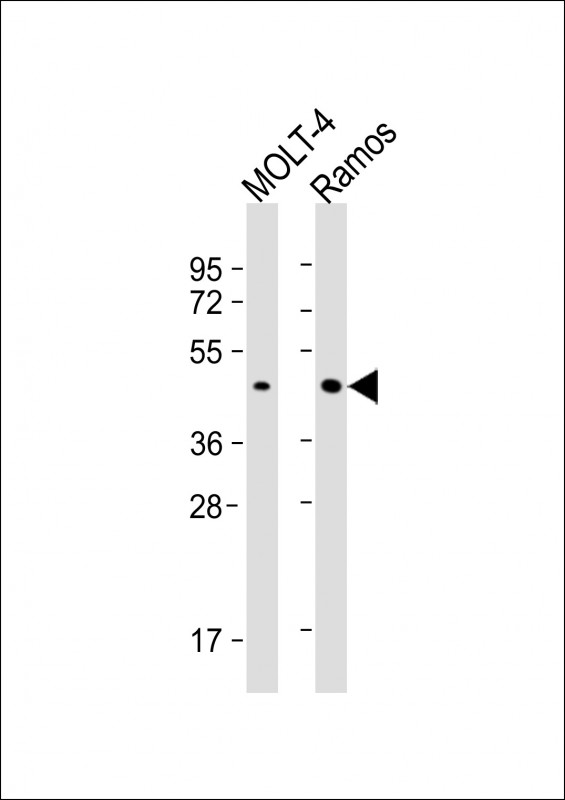BCAT1 Antibody (Center)
Affinity Purified Rabbit Polyclonal Antibody (Pab)
- SPECIFICATION
- CITATIONS
- PROTOCOLS
- BACKGROUND

Application
| IHC-P, WB, E |
|---|---|
| Primary Accession | P54687 |
| Other Accession | P54690, P24288, NP_001171563.1, NP_001171562.1, NP_005495.2, NP_001171564.1, NP_001171565.1, Q9GKM4 |
| Reactivity | Human |
| Predicted | Mouse, Rat, Sheep |
| Host | Rabbit |
| Clonality | Polyclonal |
| Isotype | Rabbit IgG |
| Calculated MW | 42966 Da |
| Antigen Region | 81-107 aa |
| Gene ID | 586 |
|---|---|
| Other Names | Branched-chain-amino-acid aminotransferase, cytosolic, BCAT(c), Protein ECA39, BCAT1, BCT1, ECA39 |
| Target/Specificity | This BCAT1 antibody is generated from rabbits immunized with a KLH conjugated synthetic peptide between 81-107 amino acids from the Central region of human BCAT1. |
| Dilution | IHC-P~~1:10~50 WB~~1:1000 E~~Use at an assay dependent concentration. |
| Format | Purified polyclonal antibody supplied in PBS with 0.09% (W/V) sodium azide. This antibody is purified through a protein A column, followed by peptide affinity purification. |
| Storage | Maintain refrigerated at 2-8°C for up to 2 weeks. For long term storage store at -20°C in small aliquots to prevent freeze-thaw cycles. |
| Precautions | BCAT1 Antibody (Center) is for research use only and not for use in diagnostic or therapeutic procedures. |
| Name | BCAT1 |
|---|---|
| Synonyms | BCT1, ECA39 {ECO:0000303|PubMed:8692959} |
| Function | Catalyzes the first reaction in the catabolism of the essential branched chain amino acids leucine, isoleucine, and valine. |
| Cellular Location | Cytoplasm {ECO:0000250|UniProtKB:P54690}. |
| Tissue Location | During embryogenesis, expressed in the brain and kidney. Overexpressed in MYC-induced tumors such as Burkitt's lymphoma |

Thousands of laboratories across the world have published research that depended on the performance of antibodies from Abcepta to advance their research. Check out links to articles that cite our products in major peer-reviewed journals, organized by research category.
info@abcepta.com, and receive a free "I Love Antibodies" mug.
Provided below are standard protocols that you may find useful for product applications.
Background
This gene encodes the cytosolic form of the enzyme branched-chain amino acid transaminase. This enzyme catalyzes the reversible transamination of branched-chain alpha-keto acids to branched-chain L-amino acids essential for cell growth. Two different clinical disorders have been attributed to a defect of branched-chain amino acid transamination: hypervalinemia and hyperleucine-isoleucinemia. As there is also a gene encoding a mitochondrial form of this enzyme, mutations in either gene may contribute to these disorders. Alternatively spliced transcript variants have been described.
References
Eijgelsheim, M., et al. Hum. Mol. Genet. 19(19):3885-3894(2010)
Bailey, S.D., et al. Diabetes Care 33(10):2250-2253(2010)
Rose, J.E., et al. Mol. Med. 16 (7-8), 247-253 (2010) :
Barber, M.J., et al. PLoS ONE 5 (3), E9763 (2010) :
Talmud, P.J., et al. Am. J. Hum. Genet. 85(5):628-642(2009)
If you have used an Abcepta product and would like to share how it has performed, please click on the "Submit Review" button and provide the requested information. Our staff will examine and post your review and contact you if needed.
If you have any additional inquiries please email technical services at tech@abcepta.com.













 Foundational characteristics of cancer include proliferation, angiogenesis, migration, evasion of apoptosis, and cellular immortality. Find key markers for these cellular processes and antibodies to detect them.
Foundational characteristics of cancer include proliferation, angiogenesis, migration, evasion of apoptosis, and cellular immortality. Find key markers for these cellular processes and antibodies to detect them. The SUMOplot™ Analysis Program predicts and scores sumoylation sites in your protein. SUMOylation is a post-translational modification involved in various cellular processes, such as nuclear-cytosolic transport, transcriptional regulation, apoptosis, protein stability, response to stress, and progression through the cell cycle.
The SUMOplot™ Analysis Program predicts and scores sumoylation sites in your protein. SUMOylation is a post-translational modification involved in various cellular processes, such as nuclear-cytosolic transport, transcriptional regulation, apoptosis, protein stability, response to stress, and progression through the cell cycle. The Autophagy Receptor Motif Plotter predicts and scores autophagy receptor binding sites in your protein. Identifying proteins connected to this pathway is critical to understanding the role of autophagy in physiological as well as pathological processes such as development, differentiation, neurodegenerative diseases, stress, infection, and cancer.
The Autophagy Receptor Motif Plotter predicts and scores autophagy receptor binding sites in your protein. Identifying proteins connected to this pathway is critical to understanding the role of autophagy in physiological as well as pathological processes such as development, differentiation, neurodegenerative diseases, stress, infection, and cancer.



